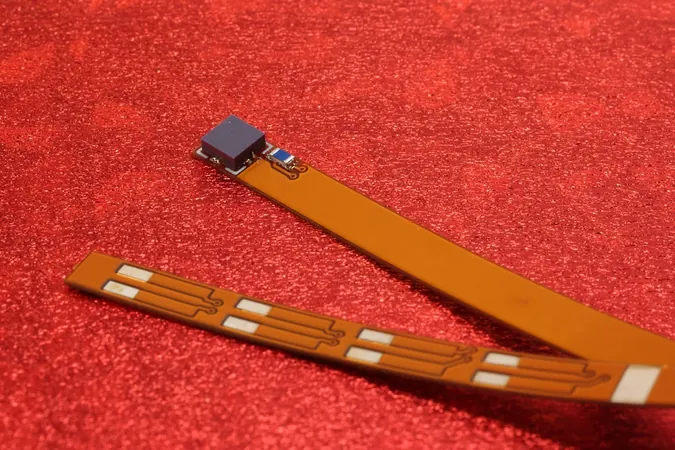
Scientists Revitalize Ancient Gene to Create a Stunning Chimeric Mouse: What This Means for Stem Cell Research!
2024-11-22
Author: Mei
In an extraordinary development, scientists have successfully reprogrammed mouse cells into pluripotent stem cells using a gene derived from choanoflagellates, a group of single-celled organisms that share a common ancestor with animals. This groundbreaking study reveals that essential genes responsible for stem cell formation may have existed nearly a billion years ago within unicellular ancestors. The researchers utilized these reprogrammed stem cells to create a chimeric mouse, effectively demonstrating how ancient genetic tools can still operate within modern mammalian systems. This discovery not only illuminates the deep-rooted evolutionary connections between primitive organisms and complex life forms but also sets the stage for potential advancements in regenerative medicine.
The chimeric mouse developed in this study showcases a striking contrast to its wild-type counterpart, featuring distinct dark eyes and black fur patches that resulted from the introduction of the choanoflagellate Sox gene. The differences, dictated by genetic markers rather than the gene itself, spotlight the innovative use of genetic science to explore the potential of stem cells.
In a collaborative effort, researchers from Queen Mary University of London and The University of Hong Kong detailed their findings in the esteemed journal Nature Communications. The research team was led by Dr. Alex de Mendoza and represents a fusion of international expertise in a field that has profound implications for both evolutionary biology and medical science.
Unlocking the Secrets of Chimeras: What Are They?
The concept of a chimeric organism—an entity made up of cells from multiple origins—stems from mythological roots, with the term originating from the legendary Chimera. In biological terms, genetic chimeras, such as the mouse created in this research, contain cells from different zygotes, a fascinating twist on natural genetics that showcases the intrinsic adaptability of biological forms.
Dr. de Mendoza remarked on the significance of their findings: “By utilizing molecular tools derived from our ancient single-celled relatives, we witness an extraordinary continuity of function across nearly a billion years of evolution.” This prompts us to contemplate the origins of multicellularity and how these genes may have laid the groundwork for complex organisms.
A Revolutionary Insight into Stem Cell Origins
The study challenges long-held beliefs that key genes, such as Sox and POU, which are crucial in maintaining stem cell pluripotency, evolved solely within animals. Instead, it suggests that these genetic components were vital in unicellular life and have been ingeniously repurposed throughout evolution.
Understanding the evolution of stem cells can dramatically enhance regenerative medicine, enabling scientists to sidestep traditional methods for cell reprogramming. As evidenced in this study, the team introduced choanoflagellate Sox genes into mouse cells, successfully transforming them into pluripotent stem cells—displaying the remarkable potential of alternate genetic pathways.
In 2012, Dr. Shinya Yamanaka’s Nobel-winning research highlighted the possibility of creating stem cells from differentiated cells using specific factors, including Sox2 and Oct4. In this new endeavor, the research team replaced Sox2 with choanoflagellate Sox genes, leading to the successful reprogramming of the cells. Upon introducing these reprogrammed cells into a developing mouse embryo, the resulting chimeric mouse vividly illustrated the far-reaching influence of ancient genes on contemporary biology.
The Future is Bright for Regenerative Medicine
This research not only uncovers the evolutionary roots of stem cells but also hints at innovative approaches to optimize stem cell therapies for treating various diseases. By diving deeper into the genetics of early life forms, researchers may unlock new methods to reprogram cells tailored for specific medical applications. Dr. Ralf Jauch, an integral collaborator in this study, emphasizes that exploring these ancient gene functions could lead to more efficient synthetic versions of the proteins that outperform their natural counterparts in certain contexts.
With each breakthrough, we inch closer to unraveling the untold stories of our biological past and how they can revolutionize our future, making this journey into the depths of evolution all the more exciting!


 Brasil (PT)
Brasil (PT)
 Canada (EN)
Canada (EN)
 Chile (ES)
Chile (ES)
 España (ES)
España (ES)
 France (FR)
France (FR)
 Hong Kong (EN)
Hong Kong (EN)
 Italia (IT)
Italia (IT)
 日本 (JA)
日本 (JA)
 Magyarország (HU)
Magyarország (HU)
 Norge (NO)
Norge (NO)
 Polska (PL)
Polska (PL)
 Schweiz (DE)
Schweiz (DE)
 Singapore (EN)
Singapore (EN)
 Sverige (SV)
Sverige (SV)
 Suomi (FI)
Suomi (FI)
 Türkiye (TR)
Türkiye (TR)